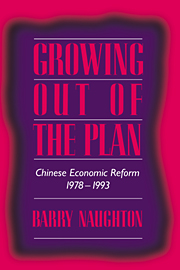Book contents
- Frontmatter
- Contents
- Tables and figures
- Preface
- Introductory
- Phase one The bird in the cage, 1979–1983
- 2 Crisis and response: Initial reorientation of the economy
- 3 State sector reforms, 1979–1983
- 4 Growth of the non-state sector
- Phase two Reforms take off, 1984–1988
- Phase three To a market economy
- Statistical appendix
- Notes
- Bibliography
- Index
4 - Growth of the non-state sector
Published online by Cambridge University Press: 03 May 2010
- Frontmatter
- Contents
- Tables and figures
- Preface
- Introductory
- Phase one The bird in the cage, 1979–1983
- 2 Crisis and response: Initial reorientation of the economy
- 3 State sector reforms, 1979–1983
- 4 Growth of the non-state sector
- Phase two Reforms take off, 1984–1988
- Phase three To a market economy
- Statistical appendix
- Notes
- Bibliography
- Index
Summary
The flowers I planted did not blossom;
But the willows I never wished for now throw cool shade over my garden.
–traditional Chinese poemOne of the most striking and important elements of the Chinese reform process has been the rapid and sustained growth of the non-state sector. The broad liberalization of the conditions under which non-state sectors could begin economic activity must be seen as the third crucial element of the early reform period, along with reorientation and the beginnings of institutional reform. This liberalization created the conditions for large-scale entry of new producers, in time fundamentally reshaping the Chinese economy. In a growth process taking place predominantly in rural areas, thousands of new township and village enterprises went into business, manufacturing goods, building houses, and shipping and selling goods around the country. Entry of new non-state producers transformed the industrial sector, greatly expanding the range of goods and services available on the market, and creating competition for existing state firms. The expanding output of these firms made an important contribution to China's rapid economic growth during the 1980s. At the same time, following on the heels of the successful decollectivization of agriculture in the early 1980s, the growth of rural enterprises suggests that China's countryside was a fertile breeding ground for economic reforms, a source of entrepreneurship and resources that could create alternatives to the existing state system.
- Type
- Chapter
- Information
- Growing Out of the PlanChinese Economic Reform, 1978–1993, pp. 137 - 170Publisher: Cambridge University PressPrint publication year: 1995



